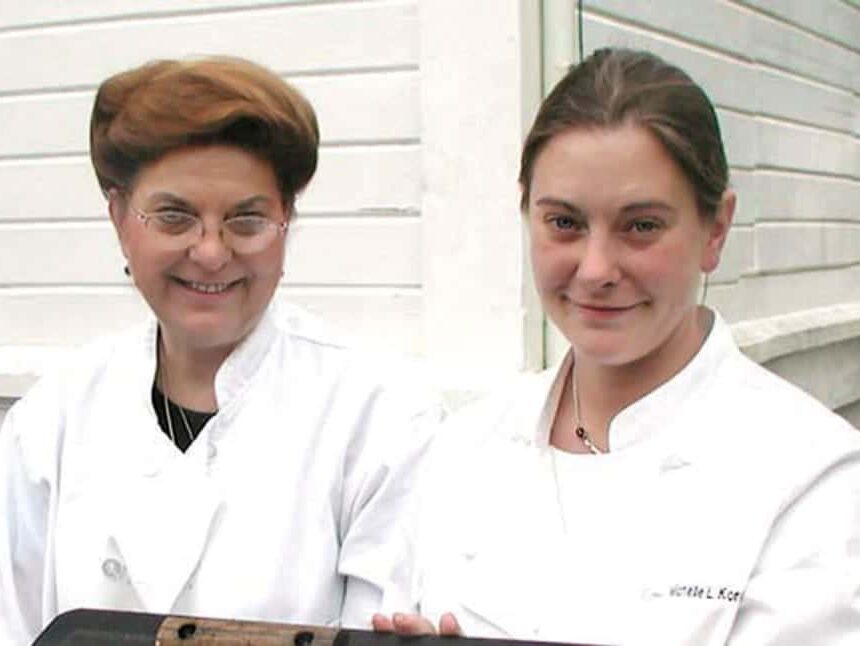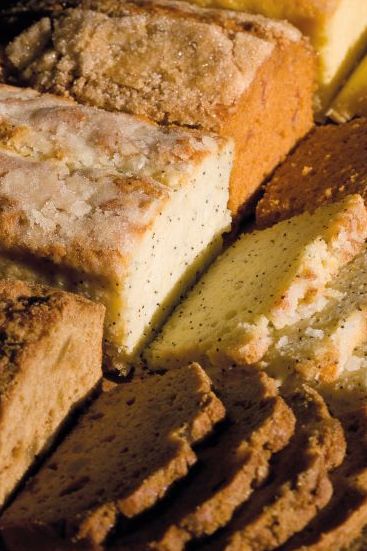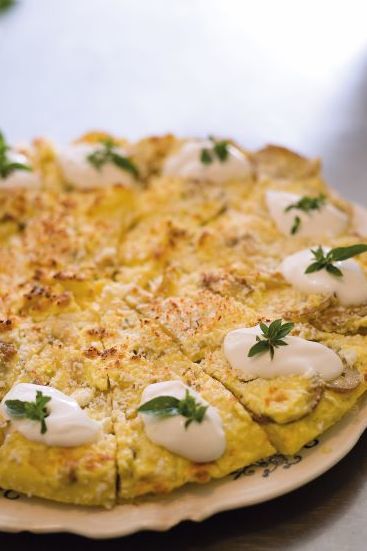Heceta Lighthouse Bed & Breakfast
April 6, 2020
7 Course Easter Brunch

Posted by: Misty
Heceta Lighthouse B&B was going to host you for the 7 Course Breakfast served as brunch on Easter... instead, you can enjoy it in your home! I have selected some recipes from The Lighthouse Breakfast Cookbook written by current owner, Michelle Korgan, and her mother, founder of the B&B, Carol Korgan, for you to serve to your family on Easter, or try any of them any day!
Course One -
Citrus Salad With Ginger CrèmeFraîche
Winter is a perfect time for this salad, with the abundance of ripe and succulent citrus fruits available. Choose a complementary variety.
1 1-inch piece fresh ginger
½ cup crème fraîche
4 teaspoons sugar
1 pomelo or ugli fruit
1 ruby red grapefruit
1 blood orange
2 honey tangerines
To peel the ginger, scrape it with the tip of a spoon. With a fine grater, shave the ginger and add it to the crème fraîche. Stir in the sugar and set aside.
Zest several curls from each fruit before removing the rind. To remove the rinds, put the citrus on a cutting board and hold it steady with one hand on top of the fruit. Starting from the top and moving down, carve just between the rind and the fruit. Rotate the fruit as each strip of peel is removed until the citrus is completely peeled.
To section the fruit, cut in between the membrane that separates each section. Cut on both sides of the membrane to the center of the fruit; each section should pop out. Try not to let the sections break. (After removing all the sections, squeeze the fruit of its remaining juice and drink it!) Some citrus has very thin sections and would be too difficult to section this way. Therefore, after you cut off the rind, thinly slice the citrus into rounds and then perhaps quarter them.
Lay out small plates. To serve, start with the largest wedges and place them in a circle around each plate’s edge. Face them in the same direction with the points in the middle coming in toward each other. Descend in size so you fill in the gaps between the larger pieces, eventually ending with the smallest piece. You’ll see a flower shape emerge. Arrange any fruit cut into quarters in the middle of the plate. Spoon a small dollop of the crème fraîche mixture in the center. Accent the center with the reserved zest curls. Serve a small plate to each guest.
Makes 6 small plates.
Course Two -
Brownie’s Rare and Famous Cranberry Bread
This recipe is from Michelle’s sister-in-law’s grandmother Brownie. It’s been said she was as sweet, nutty, and zesty as the bread. Thanks for the recipe, Brownie!
4 cups fresh or frozen cranberries
4 cups all-purpose flour
3 teaspoons baking powder
1 teaspoon baking soda
1 teaspoon salt
1½ cups unsalted butter
3 cups sugar
3 large eggs
Zest from 2 oranges
1½ cups hazelnuts, walnuts, or pecans, finely chopped
Preheat the oven to 350°F and oil three 8-by-4-inch bread pans with baking spray.
In a food processor pulse cranberries until they are fairly minced but not pasty. Set aside.
Sift the flour, baking powder, baking soda, and salt together. Set aside.
Cream the butter until light. Add the sugar and beat until fluffy. Add the eggs one at a time until well mixed. Scrape down the sides and bottom and mix again. Add the zest. Add the dry ingredients and mix just to blend. Mix in the cranberries and nuts. If you are using a mixer, it will be easier to add the cranberries and nuts by hand because the batter will be very thick.
Divide the batter among the pans. Place the pans on a baking sheet and bake for about 1 hour, turning the pans at 30 minutes and checking at 50 minutes. Breads are done when a toothpick inserted in the center of 2 breads comes out clean. Let rest for 20 minutes; turn out and let rest on a wire rack until completely cool.
Makes 3 loaves.
Course Three -
Bay Shrimp Mousse
Oregon fisheries catch about 20 million pounds of bay shrimp a year, and according to the Marine Stewardship Council, our shrimp harvesting is certified as a sustainable practice. We can feel good about eating this mousse for two reasons: its creamy, rich taste and the fisheries’ responsible fishing practices.
3 scallions, thinly sliced diagonally to the dark green part, divided
1½ ounces cream cheese
1 ounce plain chèvre
2 teaspoons lemon juice
5 small sprigs fresh dill, divided
Salt
Pinch white pepper
1½ cups bay shrimp, divided
Thinly sliced lemon, for garnish
Thinly sliced cucumbers
Grape or cherry tomatoes, halved lengthwise
6 warm crumpets
Place one-third of the scallions (the whitest part), cream cheese, chèvre, lemon juice, 4 sprigs of dill, a pinch of salt, and pepper in the bowl of a small food processor. Blend until creamy and smooth, stopping to scrape down the sides. Add ¾ cup of the shrimp and pulse; do not overblend. The mixture should be creamy but have some small bits of shrimp visible.
Transfer the mousse to a decorative bowl. Top with the remaining ¾ cup shrimp, the remaining scallions, and the remaining sprig of dill. Garnish with lemon slices. Serve on a plate with the cucumber and tomatoes. Pass around the table with the crumpets.
Makes 6 servings
Course Four -
Strawberry Candied Ginger and Fresh Mint
Fresh mint grows like a weed, and it’s a weed we’ll always invite. All are nice to play with in different foods and drinks. The best way to tell whether you want to use a particular herb for a dish is to take a bit from the plant, bruise it between your fingers, close your eyes, and smell the fragrance while thinking about the foods you want to use it with. Does it still sound like a good match? Then try it out.
3 small chunks candied ginger, divided
1 to 1½ cups water, divided
¾ cup whole milk yogurt
⅓ cup sugar
3 cups frozen strawberries
6 fresh mint leaves, coarsely chopped
Freshly whipped cream
6 mint buds
In a blender mix the ginger (reserving 6 slivers for garnish), 1 cup of the water, yogurt, and sugar until well blended. Add the strawberries and just enough additional water to make a smooth consistency. Add the mint leaves and blend just until mixed.
Serve in pretty, clear glasses topped with the cream and garnished with a sliver of the candied ginger and the mint bud.
Makes 6 small servings
Course Five -
Potato, Swiss Chard, and Rosemary Frittata
Every summer we look forward to visiting Johnson’s Farm in Eugene, Oregon. Starting in June it seems with every visit there is a new berry or fresh produce to pick from, including a huge barrel of new potatoes. Michelle paws through the potatoes looking for the smallest reds and whites because she knows they will be the sweetest and creamiest of the bunch. Back at Heceta Head we roast the potatoes in olive oil for 30 to 40 minutes, roll them in freshly chopped rosemary and parsley, and sprinkle them with kosher salt. Hot out of the oven, the skins just burst and release the most creamy potato goodness. The next day they are just as wonderful because the herbs have infused the potato. Heceta’s garden bursts with large bunches of rainbow colored chard. Our farm fresh eggs are a perfect vehicle for this combination.
3 baby red potatoes, roasted with rosemary and Italian parsley, thinly sliced, divided 1
2 large eggs
3 tablespoons mayonnaise
1 tablespoon clarified butter
⅓ sweet onion, diced
2 leaves Swiss chard leaves, ribs removed, washed and chopped
¼ cup finely grated pecorino Romano
¼ cup crème fraîche
6 fresh rosemary sprigs, for garnish
Prepare the potatoes and set aside.
In a large bowl whisk the eggs with the mayonnaise until airy. Set aside. Preheat the broiler to high.
Heat a 10-inch nonstick skillet over medium heat. Add the butter and onion and cook until the onion is soft. Add the potatoes, reserving 6 slices for garnish, and cook over medium heat until light brown, about 5 to 7 minutes. Add the chard and sauté until it is wilted and soft. Add the eggs and let them set a bit, but do not let them brown. (If they are getting brown, the temperature is too high.) With a rubber spatula, push the eggs from the bottom and sides and let the next layer go to the bottom and set. Repeat until all the eggs are soft. Let them sit about 1 to 2 minutes to set the eggs. The frittata should easily come away from the pan. Sprinkle the Romano over the top.
Place the skillet under the broiler with the handle sticking out of the oven. Broil until the Romano starts to brown and the eggs are set. Run a rubber spatula around the skillet rim to loosen the sides, tilt the skillet, and slide the frittata onto a serving platter. Cut into 6 pieces. Garnish with a dollop of crème fraîche, a thin slice of potato, and a sprig of rosemary. Using a pie server, serve a piece to each guest.
Makes 6 servings.
Course Six -
Roasted Garlic Chicken Sausage
The mild taste of roasted garlic makes this sausage nice for mornings, and it is delicate enough to serve with eggs and Oregon truffles. It is also nice with pasta and fresh garden vegetables.
8 cloves garlic, roasted and mashed
1 pound ground chicken
2 teaspoons Dijon mustard
2 teaspoons chopped fresh Italian parsley
1 tablespoon capers 2 tablespoons dry white wine or vermouth
¾ teaspoon salt
½ teaspoon white pepper
¼ cup fresh bread crumbs
Mix the garlic, chicken, mustard, parsley, capers, wine, salt, pepper, and bread crumbs. Refrigerate 2 hours or overnight.
To serve, form into patties and brown on both sides in a skillet over medium heat until cooked through.
Makes about 1 pound
Course Seven -
Pear Tart
Mike (Carol's husband and co-founder) hates to serve this tart to our guests. The only way he will agree to serve it is if we agree to make a tart just for him. This is light and simple. It is one of the best ways we know how to show off our Oregon state fruit.
½ cup unsalted butter
2 cups all-purpose flour
1 teaspoon salt
4 to 5 tablespoons ice water
Lightly sweetened whipped heavy cream, for garnish
Freshly ground nutmeg, for garnish
Filling
8 cups Bartlett or Comice pears
½ cup sugar
2 teaspoons lemon zest, grated
4 tablespoons lemon juice
¼ cup small tapioca
Peel, core, and slice the pears ⅛ inch thick. Toss with the sugar, zest, lemon juice, and tapioca.
Topping
¾ cup all-purpose flour
¾ cup sugar
1 teaspoon grated fresh ginger
¾ teaspoon ground cinnamon
¼ teaspoon mace
¼ cup butter
In a medium bowl, mix the flour, sugar, ginger, cinnamon, and mace. Cut in the butter until a crumble forms.
In a large bowl, cut the butter into the flour and salt until it is a crumble. Using your fingers gently stir in 4 tablespoons of the ice water. If the dough comes together without crumbling, you will not need the last tablespoon of water. If it still crumbles, add the remaining 1 tablespoon of water. Bring the dough together without working it too much or it will become tough. Form into a disk, cover with plastic wrap, and refrigerate until chilled, at least 1 hour.
Preheat the oven to 400°F. On a lightly floured surface, roll out the pastry to about 13 inches in diameter for a 12-inch tart pan. Fold the dough in half and slide it over the tart pan. Unfold the dough and gently press the edges into the pan. Do not over-compress the dough or it will shrink and become tough when it bakes. Arrange the pears evenly on the unbaked shell and cover with the topping. Bake for 45 minutes.
Serve at room temperature with the whipped cream and the nutmeg.
Makes 8-10 servings.
Happy Eating!!





